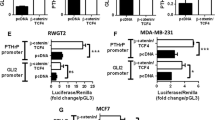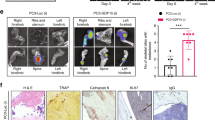Abstract
We analysed the glucocorticoid receptor (GR) function and its ability to modulate cell-cell interactions between the PA-III rat prostate cancer and UMR 106 osteoblast-like rat osteosarcoma cells as an in vitro model for studying GR function in PA-III cell-induced tumor and blastic reaction in rat bone. Intact GR was detected by ligand binding assays, DNA band-shift, and GR trans-activation analysis of PA-III and UMR 106 cells transiently transfected with the mouse mammary tumor virus thymidine kinase-chloramphenicol acetyltransferase reporter gene. Dexamethasone and transforming growth factor beta 1 (TGFb1) inhibited the growth of PA-III and UMR 106 cells. Dexamethasone's inhibition of PA-III and UMR 106 cells was reversed by anti-TGFb1 antibody and exogenous insulin-like growth factor I (IGF-I). Exogenous IGF-I, urokinase-type plasminogen activator (uPA), UMR 106 conditioned media (CM) and PA-III CM stimulated the proliferation of PA-III and UMR 106 cells. The mitogenic activity exerted by uPA and PA-III CM in UMR 106 cells was completely neutralized by anti-IGF-I specific antibody. In addition, dexamethasone up-regulated TGFb1 mRNA and down-regulated uPA mRNA expression in PA-III cells without affecting TGFb1 and uPA mRNA expression in UMR 106 cells. These data suggested that TGFb1, uPA, and IGF-I mediate at least in part cell-cell interactions and GR function in PA-III prostate cancer and UMR 106 osteosarcoma cells.
Similar content being viewed by others
References
Davies P and Rushmere NK, 1992, Association of glucocorticoid receptors with prostate nuclear sites for androgen receptors and with androgen response elements. J Mol Endocr, 5, 117-27.
Koutsilieris M, Grondin F and Lehoux J-G, 1992, The expression of mRNA for glucocorticoid receptor gene and functional glucocorticoid receptors detected in PA-III rat prostate adenocarcinoma cells. Anticancer Res, 12, 899-904.
Reyes-Moreno C, Frenette G, Lavergne E, Boulanger J, Govindan MV and Koutsilieris M, 1995, Mediation of glucocorticoid receptor function by transforming growth factor βeta 1 (TGFβ1) expression in human PC-3 prostate cancer cells. Prostate, 26, 260-69.
Evans RM, 1988, The steroid and thyroid hormone receptor superfamily. Science, 240, 889-95.
Jonat C, Rahmsdorf HJ, Park KK et al.1990, Antitumor promotion and antiinflamation: downmodulation of AP-1 (fos/jun) activity by glucocorticoid hormone. Cell, 60, 1189-204.
Sanchez I, Goya L, Vallerga AK and Firestone GL, 1993, Glucocorticoids reversibly arrest rat hepatoma cell growth by inducing an early G1 block in cell cycle progression. Cell Growth Different, 4, 215-25.
Johnson BH, Gomi M, Jacowlew SB, Moriwaki K and Thompson EB, 1993, Actions and interactions of glucocorticoids and transforming growth factor β on two related human myeloma cell lines. Cell Growth Differ, 4, 25-30.
Syms AJ, Norris J and Smith RG, 1984, Autocrine regulation of growth: I. Glucocorticoid inhibition is overcome by exogenous platelet derived growth factor. Biochem Biophys Res Commun, 122, 68-74.
Pollard M, Luckert PH and Scheu J, 1988, Effects of diphosphonate and X-rays on bone lesions induced in rats by prostate cancer cells. Cancer, 61, 2027-32.
Hoover DM, Best KL, McKenney BK, Tamura RN and Neubauer BL, 1990, Experimental induction of neoplasia in accessory sex organs of male Lobund— Wistar rats. Cancer Res, 50, 142-6.
Koutsilieris M, 1992, PA-III rat prostate adenocarcinoma cells. in vivo, 6, 199-204.
Galasko CSB, 1982, Mechanism of lytic and blastic metastatic disease of bone. Clin Orth Rel Res, 12, 20-5.
Koutsilieris M, Rabbani SA and Goltzman D, 1986, Selective mitogens can be extracted from prostatic tissues. Prostate, 9, 109-115.
Koutsilieris M, Rabbani SA and Goltzman D, 1987, Effects of prostatic mitogens on rat bone cells and fibroblasts. J Endocrinol, 115, 447-54.
Koutsilieris M, Rabbani SA, Bennett HPJ and Goltzman D, 1987, Characteristics of prostate-derived growth factors for cells of the osteoblast phenotype. J Clin Invest, 80, 941-6.
Rabbani SA, Desjardins J, Bell AW et al. 1990, An amino-terminal fragment of urokinase isolated from a prostate cancer cell line (PC-3) is mitogenic for osteoblast-like cells. Biochem Biophys Res Commun, 173, 1058-62.
Koutsilieris M, Frenette G, Lazure C, Lehoux J-G, Govindan MV and Polychronakos C, 1993, Urokinasetype plasminogen activator: a paracrine factor regulating the IGFs bioavailability in PA-III cell-induced osteoblastic metastases. Anticancer Res, 13, 481-6.
Koutsilieris M and Polychronakos C, 1992, Proteinolytic activity against IGF-binding proteins involved in the paracrine interactions between prostate adenocarcinoma cells and osteoblasts. Anticancer Res, 12, 905-10.
Campbell PG, Novak JF, Yanosick TB and McMaster JH, 1992, Involvement of the plasmin system in dissociation of the insulin-like growth factor-βinding protein complex. Endocrinology, 130, 1401-12.
Yee JA, Yan L, Dominguez JC, Allan EH and Martin TJ, 1993, Plasminogen-dependent activation of latent transforming growth factor βeta (TGFβ) by growing cultures of osteoblast-like cells. J Cell Physiol, 157, 528-34.
Bernard JA, Lyons RM, and Moses HL, 1990, The cell biology of transforming growth factor βeta. Biochim Biophys Acta, 1032, 79-87.
Koutsilieris M, 1993, Osteoblastic metastasis in advanced prostate cancer. Anticancer Res, 13, 443-50.
Koutsilieris M, 1995, Skeletal metastases in advanced prostate cancer: cell biology and therapy. Crit Rev Hema/Oncol, 18, 51-64.
Polychronakos C, Janthly U, Lehoux J-G and Koutsilieris M, 1991, Mitogenic effects of insulin and insulin-like growth factors on PA-III rat prostate adenocarcinoma cells: characterization of the receptors involved. Prostate, 19, 313-21.
Laemmli UK, 1970, Cleavage of structural proteins during the assembly of bacteriophage T4. Nature, 227, 680-5.
Govindan MV, 1990, Specific region in hormone binding domain is essential for hormone binding and trans-activation by human androgen receptor. Mol Endocr, 4, 417-27.
Chen TL, Cone CM and Feldman D, 1983, Glucocorticoid modulation of cell proliferation in cultured osteoblast-like bone cells: differences between rat and mouse. Endocrinology, 112, 1739-45.
Peck W, Gennari C and Raisz L, 1984, Corticosteroids and bone. Calcif Tissue Int, 36, 4-7.
Colvard DS, Eriksen EF, Keeting PE et al. 1989, Identification of androgen receptors in normal human osteoblast-like cells. Proc Natl Acad Sci USA, 86, 854-9.
Oursler MJ, Riggs L and Spelsberg TC, 1993, Glucocorticoid-induced activation of latent transforming growth factor-β by normal human osteoblastlike cells. Endocrinology, 133, 2187-96.
Boulanger J, Reyes-Moreno C and Koutsilieris M, 1995, Mediation of the glucocorticoid receptor (GR) function by the activation of latent transforming growth factor βeta 1 in MG-63 osteoblast-like osteosarcoma cells. Int J Cancer, 61, 692-7.
Delany AM and Canalis E, 1995, Transcriptional repression of insulin-like growth factor I by glucocorticoids in rat bone cells. Endocrinology, 136, 4776-81.
Koutsilieris M, Faure N, Laroche B, Tolis G, Roberts G and Ackman CFD, 1986, Objective response and disease outcome in 59 patients with stage D2 prostatic carcinoma treated with either buserelin or orchiectomy: disease aggressivity and its association with response and outcome. Urology, 27, 221-7.
Koutsilieris M, Laroche B, Thabet M and Fradet Y, 1990, The assessment of disease aggressivity in stage D2 prostate cancer patients. Anticancer Res, 10, 333-6.
Koutsilieris M, Dupont A, Gomez J et al. 1994, Stratification of stage D2 prostate cancer patients by a disease aggressiveness score and its use in evaluating disease response and outcome to combination hormone therapy (GnRH-A plus flutamide). Anticancer Res, 14, 627-34.
Tubiana-Hulin M, 1990, Traitement hormonal des metastases osseuses des cancers. Rev Rheum, 57, 821-7.
Hellmann K, Philips RH and Goold M, 1993, High dose dexamethasone and base of brain irradiation for hormone refractory metastatic carcinoma of the prostate. Clin Exp Metastasis, 11, 227-9.
Steiner MS and Barrack E, 1992, Transforming growth factor-β1 overproduction in prostate cancer: effects on growth in vivoand in vitro . Mol Endocr, 6, 15-25.
Wilding G, Zugmeier G, Knabbe C, Flanders K and Gelmann E, 1989, Differential effects of transforming growth factor β on human prostate cancer cells in vitro. Mol Cell Endocr, 62, 79-87.
Chiquet-Ehrismann R, Kalla P, Pearson CA, Beck K and Chiquet M, 1988, Tenascin interferes with fibronectin action. Cell, 53, 383-90.
Heino J, and Massaque J 1989, Transforming growth factor-β switches the pattern of integrins expressed in MG-63 human osteosarcoma cells and causes a selective loss of cell adhesion to laminin. J Biol Chem, 264, 21806-11.
Yang EY and Moses HL, 1990, Transforming growth factor β1-induced changes on cell migration, proliferation and angiogenesis in chicken chorioallantoid membrane. J Cell Biol, 111, 731-41.
Gehron-Robey P, Young MF, Flanders KC et al. 1987, Osteoblasts synthesize and respond to transforming growth factor-type β (TGF-β) in vitro. J Cell Biol, 105, 457-2.
Centrella M, Horowitz MC, Wozney JM and McCarthy TL, 1994, Transforming growth factor-β gene family members and bone. Endocr Rev, 15, 27-39.
Ibbotson KJ, Orcutt CM, Anglin AM and D'Souza SM, 1989, Effects of transforming growth factor β1 and β2 on a mouse clonal osteoblast-like cell line MC3T3-E1. J Bone Miner Res, 1, 37-44.
Koutsilieris M, Dimopoulos MA, Doillou C, Sourla A, Moreno–Reyes C and Choki I, 1996, The molecular concept of prostrate cancer. Cancer J, 9, 89–94.
Author information
Authors and Affiliations
Rights and permissions
About this article
Cite this article
Reyes-Moreno , C., Koutsilieris , M. Glucocorticoid receptor function possibly modulates cell-cell interactions in osteoblastic metastases on rat skeleton. Clin Exp Metastasis 15, 205–217 (1997). https://doi.org/10.1023/A:1018413229570
Issue Date:
DOI: https://doi.org/10.1023/A:1018413229570




